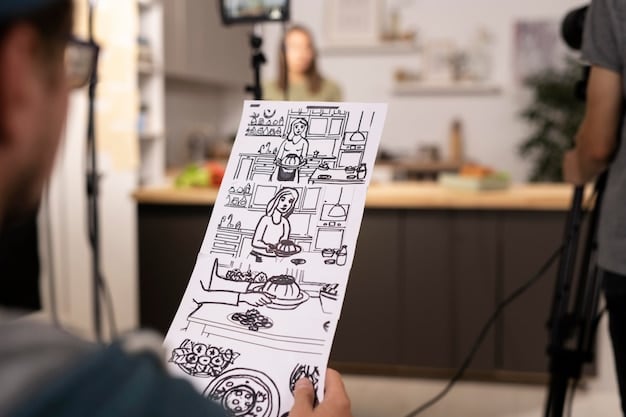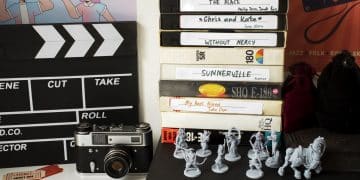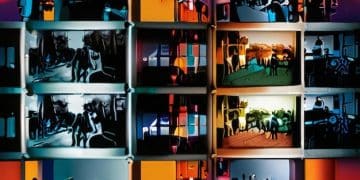Adaptation from book to screen: A deep dive into the transformation of popular limited series

The adaptation from book to screen for popular limited series involves intricate decisions regarding narrative fidelity, character development, and visual interpretation.
Each creative choice plays a vital role in capturing audience engagement and critical acclaim.
Delving into the intricate world of cinematic storytelling, the journey of adaptation from book to screen reveals a fascinating process of creative translation.
This exploration examines the multifaceted challenges and triumphs involved when literary narratives are reimagined for the episodic format, captivating audiences worldwide.
The foundational principles of adaptation
The core concept behind an adaptation from book to screen is not merely transcribing pages onto a screen.
It’s about translating the essence of a narrative designed for linear reading into a visual and auditory experience that unfolds across multiple episodes.
This transformation requires a delicate balance between fidelity to the source material and the creative liberties needed to craft a compelling visual story.
A key principle in successful adaptation from book to screen lies in understanding the strengths and limitations of each medium.
Books thrive on introspection, internal monologue, and detailed world-building. Screen media, on the other hand, depend on visual storytelling, character dynamics, and pacing that maintains audience attention.
The challenge lies in finding visual equivalents for literary devices while preserving emotional resonance.
Fidelity versus reinvention
The debate between fidelity and reinvention stands at the heart of any adaptation from book to screen.
Some creators aim for near-perfect replication of the book, while others use it as a springboard for innovation. Success depends on how well the chosen approach serves both the story and its audience.
- Strict fidelity: Preserving plot points, character arcs, and dialogue as closely as possible.
- Creative reinvention: Taking liberties with certain elements to enhance the story for television, possibly altering character fates or adding new subplots.
- Essence capture: Focusing on the thematic and emotional truth of the book, even if specific details change.
The ultimate goal of an adaptation from book to screen is to honor the spirit of the original work while creating a standalone piece of art.
Achieving this balance requires deep comprehension of the book’s themes and characters, combined with cinematic sensitivity.
The foundation of any successful limited series adaptation from book to screen lies in rigorous textual analysis, breaking down character motivations, identifying key plot points, and understanding the author’s intentions.
Without this groundwork, even ambitious adaptations risk losing the magic of the source.

Pre-Production: Developing the series bible and securing rights
Before cameras roll, pre-production for an adaptation from book to screen is a maze of legal, creative, and logistical challenges.
Securing rights to adapt a popular book is the first step, a process involving agents, publishers, and legal teams.
Once rights are obtained, the creative foundation begins: developing the series bible. This document outlines everything from backstories and mythology to tone and episode structure.
Elements of a series bible
- Logline and synopsis: A concise summary of the premise and overall arc.
- Character breakdowns: Detailed profiles for main and recurring characters, exploring motivations and growth.
- World-building: Descriptions of the setting, rules, and atmosphere — essential for fantasy or historical adaptations.
- Episode outlines: Overviews ensuring cohesive narrative flow across episodes.
- Tonal and stylistic guidelines: Defining visual aesthetics, cinematography, and design direction.
A strong series bible ensures the adaptation from book to screen maintains a unified creative vision.
It prevents misinterpretation and aligns the entire production team toward a shared goal, translating the written word into a vibrant, cinematic experience.
Beyond the creative framework, funding, and assembling a talented team of writers, producers, and directors are crucial in shaping the adaptation’s success.
Screenwriting and narrative restructuring
Transforming a novel into a limited series requires significant narrative restructuring.
Books often unfold linearly or internally, but an adaptation from book to screen must build episodic tension and rhythm.
Screenwriters identify the emotional core and major beats that translate visually.
Subplots may expand or condense to enhance pacing, while new characters or storylines emerge to suit the screen’s demands.
A well-structured adaptation from book to screen keeps each episode satisfying on its own yet integral to the broader arc. The goal is maintaining narrative coherence while maximizing emotional depth.
Adapting character voice and internal monologue
One of the greatest challenges in an adaptation from book to screen is expressing internal monologues and emotional introspection.
Books grant readers direct access to characters’ minds, something film must externalize. Writers and directors employ creative methods:
- Subtextual Dialogue: Conversations rich with hidden meanings.
- Visual Metaphors: Imagery reflecting internal conflict.
- Non-Verbal Cues: Performances, gestures, and silence conveying emotion.
Effective adaptation from book to screen turns internal thoughts into cinematic experiences. The audience doesn’t just observe, they feel the story’s heartbeat.

Casting and performance: Bringing characters to life
Casting defines the emotional success of an adaptation from book to screen. Actors must embody beloved literary figures while adding unique interpretation.
Casting directors conduct numerous auditions, chemistry reads, and workshops to ensure performers match both the character’s spirit and the show’s tone.
Developing character arc and ensemble chemistry
The chemistry among the ensemble is vital. Limited series often rely on layered relationships, so interactions must feel authentic. Directors foster this through rehearsals and character workshops.
Chemistry Reads, Character Workshops, and Rehearsals all serve one goal, transforming the adaptation from book to screen into a living, breathing portrayal of human connection.
When done right, performances transcend the source, creating iconic portrayals that define the adaptation for years.
Production design and visual storytelling
Visual storytelling is the soul of an adaptation from book to screen.
Production design, cinematography, and costume work together to build a world that reflects the book’s tone and atmosphere.
Designers research meticulously to ensure authenticity, whether re-creating a historical period or inventing a fantasy universe.
Every prop and lighting choice shapes how viewers emotionally connect to the story.
Translating atmosphere and world-building
Capturing the book’s mood visually is a defining challenge of adaptation from book to screen. Cinematography achieves this through:
- Lighting: Establishing tone and emotional intensity.
- Color Palette: Reflecting narrative mood, bright for hope, dark for tension.
- Set Dressing: Authentic details enhancing immersion.
Costume design complements this by reflecting era, personality, and transformation. Together, these elements craft a visually cohesive experience that mirrors the book’s world.
When these creative departments align, the adaptation from book to screen becomes a visual masterpiece that honors its literary roots while standing alone as an artistic achievement.
Post-Production: Editing, score, and sound design
Once filming wraps, post-production brings the adaptation from book to screen to life.
Editing, music, and sound design shape tone, emotion, and rhythm, turning raw footage into a seamless narrative.
Editors weave hours of material into coherent storytelling. Their pacing choices determine how suspense, emotion, and revelation unfold.
The power of music and sound in narrative
Music breathes emotional life into an adaptation from book to screen. Composers create thematic motifs and emotional underscoring that connect audiences to the story without a single line of dialogue.
Sound design adds realism, layering subtle effects that immerse viewers in the world, from ambient echoes to character-driven sounds.
When editing, music, and sound blend harmoniously, the adaptation from book to screen achieves full immersion, delivering not just a visual translation but an emotional one.
The adaptation from book to screen is far more than a creative exercise, it’s a transformation of storytelling itself.
Each phase, from securing rights to final editing, represents a fusion of literature and cinema, intellect and emotion.
When executed with precision and passion, the adaptation from book to screen not only honors the original work but elevates it, allowing new audiences to experience timeless stories through a fresh, cinematic lens.
| Key Aspect | Brief Description |
|---|---|
| 📖 Adapting Narrative | Translating intricate literary plots into compelling episodic structures. |
| 🎭 Casting Brilliance | Selecting actors who embody characters while adding fresh interpretation. |
| 🎨 Visual Design Magic | Creating immersive worlds via meticulous production and costume design. |
| 🎵 Sound & Score | Enhancing emotional depth and atmosphere through music and sound effects. |
Frequently Asked Questions (FAQ) about Limited Series Adaptations
Limited series offer a unique space for adaptations, allowing for deeper character and plot development than a film, while avoiding the potential pitfalls of an ongoing series. This format enables a more faithful and nuanced translation of complex narratives, providing space to explore intricate literary details and character arcs over several hours, appealing to both fans and new audiences.
Key challenges include translating internal monologues into visual storytelling, restructuring a novel’s narrative for episodic pacing, making difficult decisions on what to cut or expand while maintaining fidelity, and living up to audience expectations for beloved source material. Balancing creative liberties with respect for the original author’s vision is a constant tightrope walk for screenwriters and producers.
Author involvement varies widely, from no participation to executive producer roles. While not strictly necessary, an author’s input can provide invaluable insight into the source material’s nuances, themes, and character motivations, helping to bridge the gap between literary and visual storytelling. Their participation often reassures fans of the book’s integrity.
While subjective, some limited series adaptations are widely considered to surpass their literary counterparts. This often occurs when the adaptation enhances certain elements, streamlines pacing, or brings new perspectives and visual depth that elevate the story without betraying its essence. Strong directorial vision and exceptional performances can contribute significantly to this perception, creating a definitive version of the narrative.
Audience success often hinges on a compelling narrative, strong character portrayals, high production values, and a respectful yet innovative approach to the source material. Word-of-mouth, critical acclaim, and social media engagement also play crucial roles. Ultimately, a successful adaptation captures both the spirit of the book and the imagination of viewers, creating a memorable and impactful viewing experience.





